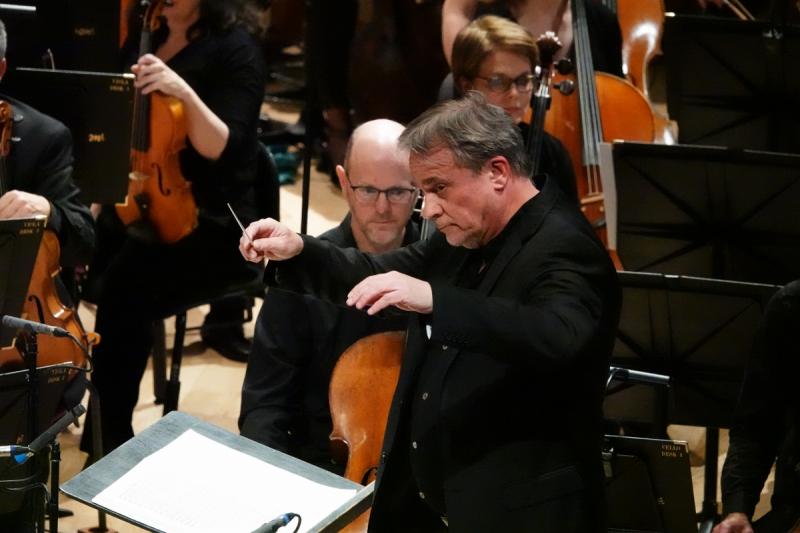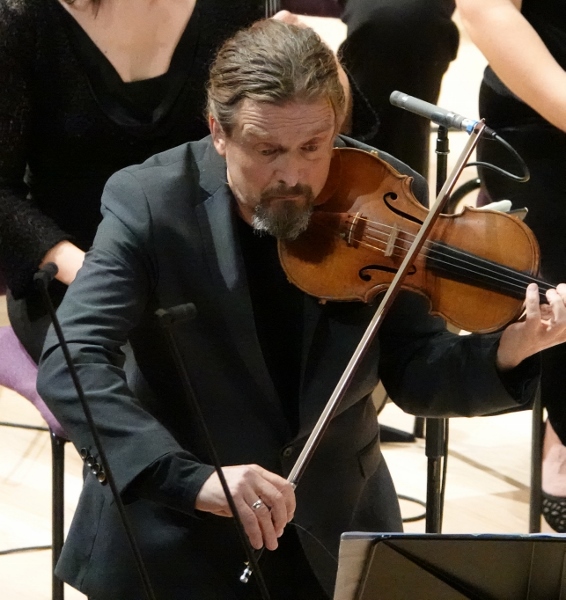Tetzlaff, BBC Philharmonic, Storgårds, Bridgewater Hall, Manchester review - something of a puzzle | reviews, news & interviews
Tetzlaff, BBC Philharmonic, Storgårds, Bridgewater Hall, Manchester review - something of a puzzle
Tetzlaff, BBC Philharmonic, Storgårds, Bridgewater Hall, Manchester review - something of a puzzle
‘Concentric Paths’ concerto fascinates as programme centrepiece

Chief conductor John Storgårds’ first programme of 2024 in the Bridgewater Hall was notable for the visit of Christian Tetzlaff as violin soloist, but perhaps a little puzzling in the choice of Thomas Adès’ Violin Concerto as the vehicle for his talents.
The concerto, sub-titled “Concentric Paths”, is a fascinating piece of orchestral composition but not the most obvious opportunity for a star soloist to engage his audience. And Bridgewater Hall attenders can hear Adès conducted by Adès in the Hallé’s series, too, now that he’s in post as artist-in-residence with them for two seasons.
Maybe we can’t get enough of him right now: it was certainly a warmly received performance, and Tetzlaff responded to the reception in the hall by picking up the score he’d just played from and pointing to it as a just object of adulation.
The concerto was itself the centrepiece of a programme that began with the charm of Prokofiev’s ballet music and ended with the serious weight of Shostakovich’s Symphony No. 1. Since it’s based on concepts of centrality and circular motion, that was the place to put it: indeed, its own second (and central) movement is its centre of gravity and the point where it attains, briefly, its most lyrical language. Much of the writing is, in typical Adès fashion, “full of noises” – exploring the extremes of pitch and varieties of colour obtainable from what is a classical-sized orchestra with some extra low brass and percussion, using the solo violin as one voice among many in the multi-part texture of the first movement and as one participant in a grand structure of repeating cycles (described as chaconne-like) in the second.
 It may come over differently on the radio, of course, as a soloist can as a result of microphone positioning. There was much for Tetzlaff (pictured left) to do, exploring the extremes of his instrument’s compass, and articulating its role against extremes of what might in any other context be thought of as an orchestra’s role of accompaniment. He accomplished this with technical brilliance and determination. The finale gave him more scope for conventional cantabile sound, along with the overlapping regular rhythmic patterns from the orchestra (its sub-title is “Rounds”), and that was beautiful. And, like with most rounds, the only way to make the music end rather than going on for ever is simply to stop. That’s what it does.
It may come over differently on the radio, of course, as a soloist can as a result of microphone positioning. There was much for Tetzlaff (pictured left) to do, exploring the extremes of his instrument’s compass, and articulating its role against extremes of what might in any other context be thought of as an orchestra’s role of accompaniment. He accomplished this with technical brilliance and determination. The finale gave him more scope for conventional cantabile sound, along with the overlapping regular rhythmic patterns from the orchestra (its sub-title is “Rounds”), and that was beautiful. And, like with most rounds, the only way to make the music end rather than going on for ever is simply to stop. That’s what it does.
The Prokofiev was his second suite from Cinderella, not the more familiar first one with the famous chiming clock effect, but featuring the Grand Waltz from the ball – usually the opportunity for lavish full-ensemble choreography when seen on stage – as well as the gentle opening of Cinderella’s Dreams (sweetly articulated by the Philharmonic strings), the Dancing Lesson and Gavotte (the two-violin duet delightfully played by leader Zoe Beyers and assistant leader Midori Sugiyama), the dances of the Spring Fairy and Summer Fairy, and other items, finishing with the Galop that accompanies the Prince’s frantic kingdom-wide search for a foot that will fit the abandoned slipper. It’s always good to hear this music performed by a concert-hall orchestra rather than coming from a theatre pit, and though the Grand Waltz as presented by Storgårds, with intriguing rhythmic irregularity and subtle articulation, might have foxed a corps de ballet if they’d tried to keep in time, it was great fun.
Before the Shostakovich symphony, we were treated to an unscheduled bonus from the conductor in the form of a Scherzo written by DSCH when he was only 17. It showed off some nice playing from principal clarinet (John Bradbury) and flute (Alex Jakeman), as well as Ian Buckle’s skills on the piano (also heard to great advantage elsewhere in the evening).
The symphony itself was done with a sense of gravity in the third and fourth movements that suited its seriousness of purpose and emotional firepower, despite the iconoclasm in the first and the Keystone-Cops dash of the second (brilliantly played by all concerned). The ending of that fast allegro was more an expression of irony than a simple joke, and, with very fine oboe playing from Jennifer Galloway and in the cello solo by Peter Dixon, the slow movement palpably gained in depth. The fourth continued this expressive impact, with the timpani solo, on three clearly different dynamic levels as played by Tim Williams, bringing drama to it, and the ending suitably ambiguous.
rating
Explore topics
Share this article
The future of Arts Journalism
You can stop theartsdesk.com closing!
We urgently need financing to survive. Our fundraising drive has thus far raised £49,000 but we need to reach £100,000 or we will be forced to close. Please contribute here: https://gofund.me/c3f6033d
And if you can forward this information to anyone who might assist, we’d be grateful.

Subscribe to theartsdesk.com
Thank you for continuing to read our work on theartsdesk.com. For unlimited access to every article in its entirety, including our archive of more than 15,000 pieces, we're asking for £5 per month or £40 per year. We feel it's a very good deal, and hope you do too.
To take a subscription now simply click here.
And if you're looking for that extra gift for a friend or family member, why not treat them to a theartsdesk.com gift subscription?
more Classical music
 Hallé John Adams festival, Bridgewater Hall / RNCM, Manchester review - standing ovations for today's music
From 1980 to 2025 with the West Coast’s pied piper and his eager following
Hallé John Adams festival, Bridgewater Hall / RNCM, Manchester review - standing ovations for today's music
From 1980 to 2025 with the West Coast’s pied piper and his eager following
 Kaploukhii, Greenwich Chamber Orchestra, Cutts, St James's Piccadilly review - promising young pianist
A robust and assertive Beethoven concerto suggests a player to follow
Kaploukhii, Greenwich Chamber Orchestra, Cutts, St James's Piccadilly review - promising young pianist
A robust and assertive Beethoven concerto suggests a player to follow
 Robin Holloway: Music's Odyssey review - lessons in composition
Broad and idiosyncratic survey of classical music is insightful but slightly indigestible
Robin Holloway: Music's Odyssey review - lessons in composition
Broad and idiosyncratic survey of classical music is insightful but slightly indigestible
 Classical CDs: Wolf-pelts, clowns and social realism
British ballet scores, 19th century cello works and contemporary piano etudes
Classical CDs: Wolf-pelts, clowns and social realism
British ballet scores, 19th century cello works and contemporary piano etudes
 Bizet in 150th anniversary year: rich and rare French offerings from Palazzetto Bru Zane
Specialists in French romantic music unveil a treasure trove both live and on disc
Bizet in 150th anniversary year: rich and rare French offerings from Palazzetto Bru Zane
Specialists in French romantic music unveil a treasure trove both live and on disc
 Scottish Chamber Orchestra, Ibragimova, Queen’s Hall, Edinburgh review - rarities, novelties and drumrolls
A pity the SCO didn't pick a better showcase for a shining guest artist
Scottish Chamber Orchestra, Ibragimova, Queen’s Hall, Edinburgh review - rarities, novelties and drumrolls
A pity the SCO didn't pick a better showcase for a shining guest artist
 Kilsby, Parkes, Sinfonia of London, Wilson, Barbican review - string things zing and sing in expert hands
British masterpieces for strings plus other-worldly tenor and horn - and a muscular rarity
Kilsby, Parkes, Sinfonia of London, Wilson, Barbican review - string things zing and sing in expert hands
British masterpieces for strings plus other-worldly tenor and horn - and a muscular rarity
 From Historical to Hip-Hop, Classically Black Music Festival, Kings Place review - a cluster of impressive stars for the future
From quasi-Mozartian elegance to the gritty humour of a kitchen inspection
From Historical to Hip-Hop, Classically Black Music Festival, Kings Place review - a cluster of impressive stars for the future
From quasi-Mozartian elegance to the gritty humour of a kitchen inspection
 Shibe, LSO, Adès, Barbican review - gaudy and glorious new music alongside serene Sibelius
Adès’s passion makes persuasive case for the music he loves, both new and old
Shibe, LSO, Adès, Barbican review - gaudy and glorious new music alongside serene Sibelius
Adès’s passion makes persuasive case for the music he loves, both new and old
 Anja Mittermüller, Richard Fu, Wigmore Hall review - a glorious hall debut
The Austrian mezzo shines - at the age of 22
Anja Mittermüller, Richard Fu, Wigmore Hall review - a glorious hall debut
The Austrian mezzo shines - at the age of 22
 First Person: clarinettist Oliver Pashley on the new horizons of The Hermes Experiment's latest album
Compositions by members of this unusual quartet feature for the first time
First Person: clarinettist Oliver Pashley on the new horizons of The Hermes Experiment's latest album
Compositions by members of this unusual quartet feature for the first time

Add comment